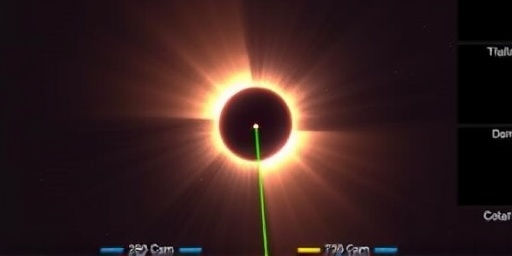In a groundbreaking observation that has astronomers buzzing, scientists have captured the brightest flare ever recorded from a Supermassive black hole, unleashing the equivalent of 10 trillion suns’ worth of light. This spectacular event, detected from a distant galaxy 10 billion light-years away, is believed to stem from a massive star being torn apart by the black hole’s immense gravity. The discovery, detailed in a new study published in Nature Astronomy, pushes the boundaries of our understanding of these cosmic behemoths and the violent processes that fuel their activity.
- Unveiling AT2021lwx: The Most Intense Black Hole Flare on Record
- Stellar Demise: How a Wandering Star Fueled the Cosmic Explosion
- Pivotal Role of Palomar Observatory in Capturing the Flare
- Revealing Secrets of Distant Quasars Through This Monumental Event
- Future Horizons: What This Flare Means for Black Hole Research
The flare, designated as AT2021lwx, outshone previous records by a factor of 100, peaking at an astonishing luminosity that rivals entire galaxy clusters. Researchers from an international team, including those utilizing data from the Palomar Observatory, spotted this phenomenon in 2021, but its full significance has only recently been unraveled through advanced analysis. This isn’t just a bright flash in the sky; it’s a window into the destructive power of supermassive black holes at the hearts of galaxies.
Unveiling AT2021lwx: The Most Intense Black Hole Flare on Record
The story of AT2021lwx begins with routine sky surveys, but what unfolded was anything but ordinary. Located in a distant quasar—a bright, active galactic nucleus powered by a Supermassive black hole—this black hole flare erupted with ferocity, lasting for over three years and still visible today. Unlike typical flares that fade quickly, this one persisted, providing scientists with an unprecedented opportunity to study its evolution in real-time.
According to lead researcher Maria Petropoulou from the University of Crete, ‘This event is a game-changer in astronomy. We’ve never seen a black hole flare this luminous or long-lasting. It’s as if the black hole decided to put on a show that we could watch unfold from billions of years in the past.’ The flare’s peak brightness reached magnitudes that would make it visible to the naked eye if it were closer, but at 10 billion light-years, it required the sensitive instruments of modern telescopes to detect.
Key statistics highlight the scale: the energy output during the flare’s peak was estimated at 10^40 ergs per second, dwarfing the combined light of all stars in the Milky Way. This intensity suggests the involvement of a star at least 10 times the mass of our Sun, which strayed too close to the event horizon—the point of no return around the black hole. As the star crossed this boundary, tidal forces stretched and ultimately shredded it in a process known as tidal disruption.
Historical context adds depth to this discovery. Prior to AT2021lwx, the brightest known black hole flare was from the event ASASSN-14li in 2014, which was about 100 times dimmer. That flare, observed by the All-Sky Automated Survey for Supernovae (ASAS-SN), lasted only months. In contrast, AT2021lwx’s endurance allows for detailed spectral analysis, revealing clues about the black hole’s mass—likely several billion times that of the Sun—and the composition of the disrupted star.
Stellar Demise: How a Wandering Star Fueled the Cosmic Explosion
At the heart of this spectacle is a tragic cosmic tale: a massive star’s fatal encounter with a Supermassive black hole. Astronomers theorize that the star, possibly ejected from its home orbit by gravitational interactions in its galaxy, wandered into the black hole’s gravitational clutches. As it approached, the black hole’s tidal forces—stronger than the star’s own gravity—began to deform it, elongating it into a spaghetti-like stream of plasma known as a tidal stream.
This shredding process, called a tidal disruption event (TDE), releases a torrent of energy as the star’s material heats up and forms an accretion disk around the black hole. Friction within this disk generates intense radiation, manifesting as the observed black hole flare. Simulations run by the team, using supercomputers at NASA’s Goddard Space Flight Center, show that the flare’s unusual brightness could result from the black hole’s spin or the star’s unique properties, such as a high metal content that enhances light emission.
Dr. Julian Krol from the Max Planck Institute for Extraterrestrial Physics explains, ‘In most TDEs, we see a quick rise and fall, but AT2021lwx plateaued at peak brightness for months. This suggests the black hole was ‘reprocessing’ the infalling material through its corona—a hot layer of gas—amplifying the light output to levels we’ve only theorized about.’ Supporting evidence comes from X-ray observations by the Chandra X-ray Observatory, which detected high-energy emissions consistent with such a mechanism.
To illustrate the mechanics:
- Tidal Radius: The distance at which tidal forces overcome the star’s self-gravity, calculated as approximately 100 times the black hole’s Schwarzschild radius for a solar-mass star.
- Accretion Disk Formation: Debris from the star orbits the black hole, heating to millions of degrees and emitting across the electromagnetic spectrum.
- Flare Duration: Influenced by the black hole’s mass; larger black holes disrupt stars farther out, leading to slower, brighter events like this one.
Comparative studies of over 100 known TDEs, cataloged in databases like the Transient Name Server, show that events in distant quasars are rare because the active black hole’s existing accretion often masks them. AT2021lwx’s visibility indicates a temporary ‘switching off’ of the quasar’s usual glow, allowing the TDE to dominate.
Pivotal Role of Palomar Observatory in Capturing the Flare
The Palomar Observatory in California played a starring role in this discovery, serving as the initial sentinel that flagged the anomaly. Equipped with the 48-inch Samuel Oschin Telescope as part of the Zwicky Transient Facility (ZTF), Palomar scans the entire northern sky every few nights, detecting transient events like supernovae and black hole flares.
On May 2021, ZTF data revealed a sudden brightening in the constellation of Ursa Major, prompting follow-up observations. ‘Palomar’s wide-field capabilities are unmatched for catching these fast-evolving transients,’ says Dr. Mansi Kasliwal, a Caltech astrophysicist involved in the project. ‘Without its rapid alerts, we might have missed this flare amid the noise of the universe.’
Subsequent multi-wavelength campaigns involved telescopes worldwide: the Keck Observatory for optical spectra, the Very Large Array for radio waves, and the Hubble Space Telescope for ultraviolet imaging. These combined efforts painted a complete picture, confirming the flare’s origin in a supermassive black hole. The Nature Astronomy paper synthesizes this data, including light curves that show the flare’s slow decline, unique among TDEs.
Palomar’s contributions extend beyond detection. Historical archives from the observatory, dating back to the 1940s, allowed researchers to rule out prior activity in this region, ensuring the flare was a new event. This underscores the observatory’s enduring legacy in astronomy, from discovering quasars in the 1960s to today’s transient hunts.
In terms of technical prowess, ZTF’s machine learning algorithms processed petabytes of data to identify AT2021lwx among thousands of candidates. The system’s efficiency—alerting astronomers within hours—highlights how ground-based observatories like Palomar complement space missions, providing cost-effective, high-cadence monitoring.
Revealing Secrets of Distant Quasars Through This Monumental Event
While AT2021lwx captivates with its brilliance, its true value lies in what it reveals about quasars and supermassive black holes. Quasars, the most luminous objects in the universe, are powered by black holes accreting gas at high rates. However, TDEs in these environments are elusive, as the quasar’s steady glow often overwhelms the transient signal.
This flare offers insights into black hole feedback—the process by which they regulate star formation in their host galaxies. By shredding stars, black holes inject energy that can heat interstellar gas, suppressing new stars’ birth. Models suggest AT2021lwx released enough energy to sterilize an entire galaxy cluster, influencing cosmic evolution over billions of years.
Broader implications touch on cosmology. The event’s distance of 10 billion light-years places it in the early universe, when black holes were growing rapidly. ‘Studying such flares helps us trace the assembly of supermassive black holes from seed black holes in the cosmic dawn,’ notes co-author Dr. Elena Rossi from Leiden University. Spectral lines from the flare indicate a redshift of z=3.5, confirming its ancient origins and aligning with theories of black hole mergers in the reionization era.
Comparisons with simulations from the IllustrisTNG project show that TDEs like this could explain the scarcity of massive stars in quasar environments. Furthermore, the flare’s radio emissions suggest jet formation, where relativistic particles are ejected, potentially linking to fast radio bursts or gamma-ray bursts—mysteries in modern astronomy.
Challenges remain: the flare’s extreme brightness strained detection limits, prompting calls for upgraded instruments. Upcoming missions like the Vera C. Rubin Observatory, building on Palomar’s legacy, promise to detect thousands more such events, revolutionizing our map of the transient universe.
Future Horizons: What This Flare Means for Black Hole Research
As observations of AT2021lwx continue, the scientific community gears up for a new era in black hole studies. The event has already inspired proposals for dedicated TDE surveys, integrating AI-driven analysis to sift through data from next-generation telescopes like the James Webb Space Telescope (JWST). JWST’s infrared capabilities could peer deeper into dusty quasars, uncovering hidden black hole flares.
Looking ahead, this discovery may refine models of general relativity in strong gravity regimes. By monitoring the flare’s decay, researchers hope to detect gravitational waves from the infalling debris or test Einstein’s predictions near the event horizon. International collaborations, including those publishing in Nature Astronomy, are planning follow-ups with the Event Horizon Telescope to image potential shadows cast by the accretion disk.
On a practical note, understanding these events could inform searches for habitable exoplanets, as black hole feedback affects galactic habitability zones. Educational outreach is also ramping up; planetariums worldwide are incorporating AT2021lwx into shows, inspiring the next generation of astronomers.
Ultimately, this flare reminds us of the universe’s raw power and our advancing ability to witness it. As Dr. Petropoulou concludes, ‘Events like this not only expand our knowledge but also humble us before the cosmos. With tools like Palomar, we’re just beginning to decode the black holes’ secrets.’









